North Carolina, with its extensive coastline, numerous freshwater bodies, and diverse climates, provides an ideal sanctuary for a variety of water birds. These avian species, showcasing an impressive array of sizes, colors, and behaviors, constitute a significant part of the state’s vibrant biodiversity.
North Carolina water birds
North Carolina, with its diverse ecosystems ranging from the Appalachian Mountains to the Atlantic Coast, is home to a wide variety of water bird species. Here are some of the most common water birds you might find in North Carolina:
| Species | Frequency | Where to Find in North Carolina |
|---|---|---|
| Brown Pelican | Common | Along the entire coastline of the state |
| Double-Crested Cormorant | Very Common | Lakes, rivers and coastal areas statewide |
| Mute Swan | Very Common | Lakes, rivers and coastal areas statewide |
| Great Blue Heron | Very Common | Wetlands, rivers and lakes statewide |
| Canada Goose | Very Common | Wetlands, rivers and lakes statewide |
| Great Egret | Common | Coastal areas, large inland reservoirs |
| Snowy Egret | Common | Coastal areas, particularly in marshes and lagoons |
| Green Heron | Common | Wetlands, rivers and lakes statewide |
| Black-Crowned Night-Heron | Uncommon | Coastal marshes, urban wetlands |
| Yellow-Crowned Night-Heron | Uncommon | Coastal areas, river basins |
| Mallard | Very Common | Lakes, ponds, and rivers statewide |
| Wood Duck | Very Common | Freshwater marshes, rivers, and ponds statewide |
| Blue-Winged Teal | Uncommon | Wetlands statewide during migration |
| Northern Pintail | Uncommon | Coastal areas during migration |
| Redhead | Uncommon | Coastal areas, particularly Pamlico Sound |
| Ring-Necked Duck | Common | Inland lakes and ponds during winter |
| Bufflehead | Common | Coastal areas during winter |
| Hooded Merganser | Common | Freshwater lakes and rivers statewide |
| Common Merganser | Uncommon | Mountain rivers and reservoirs |
| American Coot | Common | Lakes, ponds and coastal areas statewide |
| American Wigeon | Uncommon | Coastal areas during migration |
| Black Skimmer | Uncommon | Coastal beaches and sandbars |
| Belted Kingfisher | Common | Lakes, ponds and coastal areas statewide |
| White Ibis | Common | Coastal marshes and wetlands |
Water Bird Species Found in North Carolina
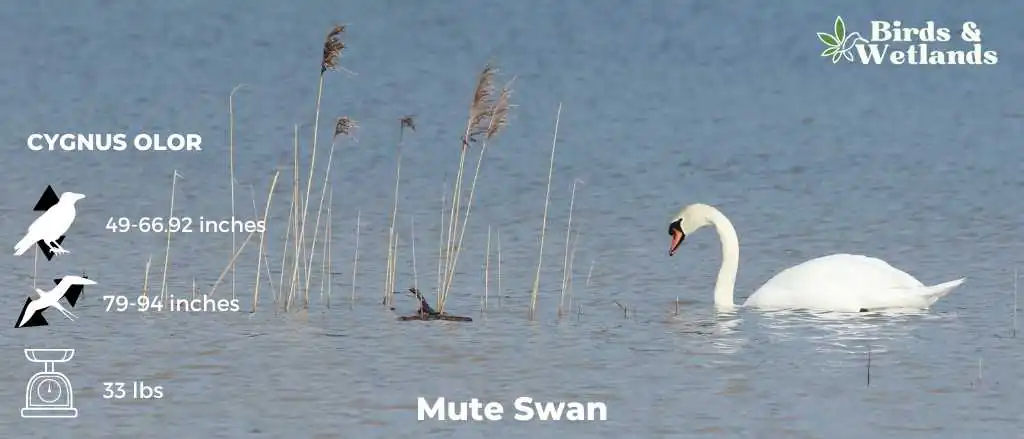

Listen:
Scientific Name: Cygnus olor
Length: 125 – 170 cm
Wingspan: 200 to 240 cm
Weight: 33 lb
The Mute Swan is an elegant and recognizable waterfowl species, well-known for its serene beauty and strikingly graceful presence on many of North America’s waterways.
Appearance: Mute Swans are large birds with a long, curved neck and a distinctive orange beak with a black knob at the base. They’re primarily white in color, with males (known as cobs) and females (known as pens) looking similar.
Diet: Mute Swans are herbivores, mainly feeding on a variety of submerged aquatic vegetation. They use their long necks to reach plants growing in deeper waters.
Reproduction: Mute Swans usually mate for life. Their nests are large and located near the water’s edge. Females lay a clutch of 5 to 7 eggs, which are incubated for about a month before hatching.
Brown Pelican (Pelecanus occidentalis)
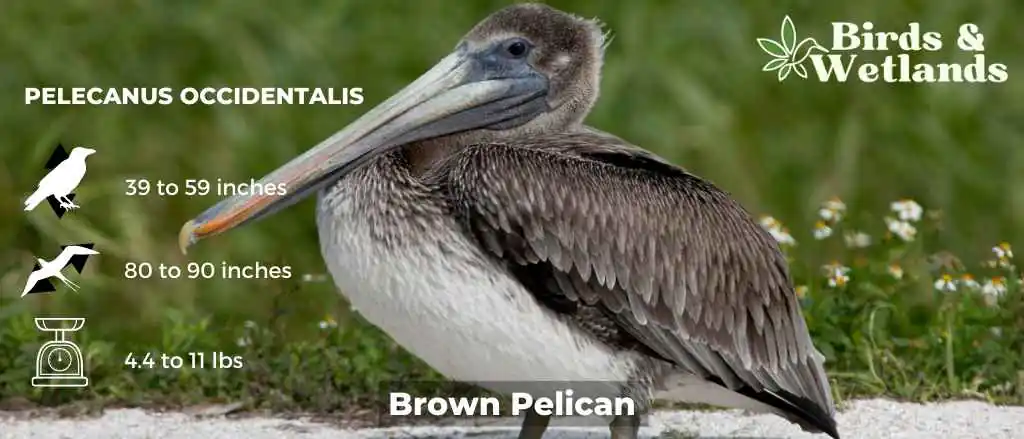
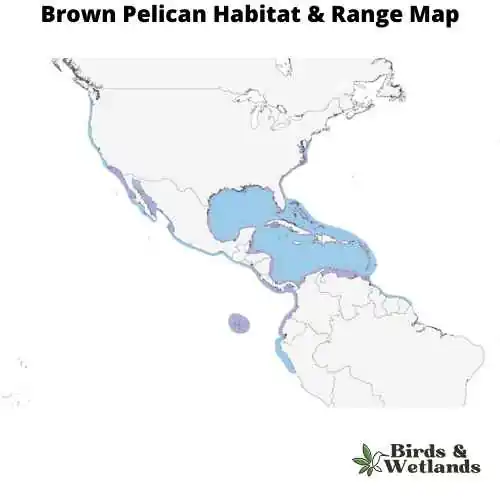
Listen:
Scientific Name: Pelecanus occidentalis
Length: 3 ft 3 in to 5 ft 0 in
Wingspan: 6 ft 8 in to 7 ft 6 in
Weight: 4.4 to 11.0 lb
The Brown Pelican is a large water bird famous for its distinct body shape and dramatic feeding habits. Known for their habit of diving headfirst into the water to catch fish, they are a staple along the coasts of the southern United States.
Appearance: Brown Pelicans are easily identifiable due to their long, curved necks, stout bodies, and large bills with a stretchy pouch. As their name suggests, they have brown and gray body feathers, with a paler head and neck that can become yellowish in breeding season.
Diet: Their diet mainly consists of fish, which they catch by making spectacular plunging dives from the air, scooping up the fish in their expandable bill pouches. They then drain the water from their pouches before swallowing their catch.
Reproduction: Brown Pelicans nest in colonies on islands, laying 2 to 3 eggs in nests made from sticks and vegetation. Both parents share incubation and feeding duties. After hatching, the chicks remain in the nest for around 12 weeks before they are ready to leave.
Double-crested cormorant

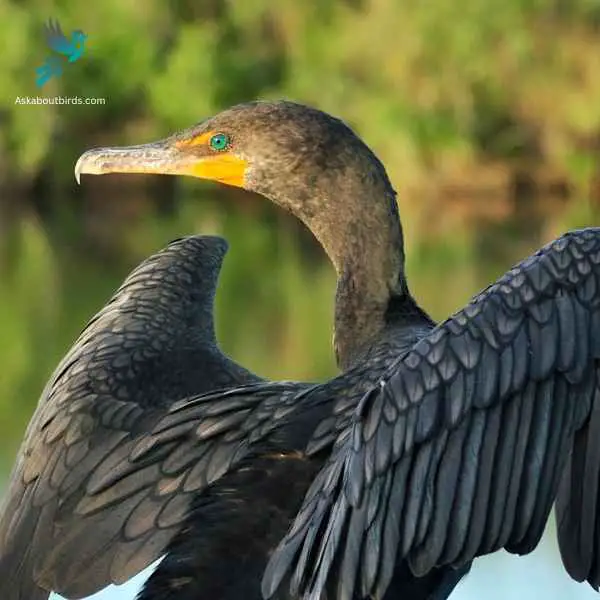
| Feature | Measurement |
|---|---|
| Scientific Name | Nannopterum auritum |
| Length | 28–35 in |
| Wingspan | 45–48 in |
| Weight | 1.2–2.5 kg |
The Double-Crested Cormorant (Phalacrocorax auritus) is a large waterbird known for its long neck, hooked bill, and almost entirely black body. The species gets its name from the two small patches of tufted feathers or “crests” found on the heads of breeding adults, one on each side. These birds are strong swimmers that propel themselves underwater with their webbed feet, their bodies submerged and necks above the water surface, giving them a characteristic snake-like appearance when swimming.
Double-Crested Cormorants are widely distributed across North America and can be found in a variety of aquatic environments including freshwater lakes, coastal areas, and rivers. Their diet primarily consists of fish, which they catch by diving from the water’s surface. Often seen perched with wings outstretched to dry after fishing, these cormorants nest in trees, on the ground, or on cliff edges, usually in colonies. While they have rebounded from decreases in the mid-20th century due to DDT-related reproductive failures, they face ongoing threats from habitat loss, entanglement in fishing gear, and conflicts with fisheries over their consumption of fish. Protection and careful management of their habitats are key to their ongoing conservation.
Great Blue Heron


| Feature | Measurement |
|---|---|
| Scientific Name | Ardea herodias |
| Length | 36–54 in |
| Wingspan | 66–79 in |
| Weight | 1.82–3.6 kgs |
Great Blue Herons are the largest heron species in North America, is distinguished by its tall stature and unique blue-gray plumage.
Measuring up to 4.5 feet tall with a wingspan of approximately 6.5 feet, the bird features a long, pointed bill, a white head with a black eye stripe extending to slender black plumes, and robust, elongated legs. Its distinctive flight pattern, forming a tight “S” shape with its neck, sets it apart from similar large birds, like cranes.
Inhabiting various wetland habitats, including marshes, lakes, rivers, and coastal regions throughout much of North and Central America, the Great Blue Heron is a wading bird. Often seen poised statue-like at the water’s edge, these birds are expert hunters, spearing fish and capturing small animals with their sharp bills.
Great Egret


| Feature | Measurement |
|---|---|
| Scientific Name | Ardea alba |
| Length | 31 to 41 in |
| Wingspan | 52 to 67 in |
| Weight | 1.5 to 3.3 lbs |
The Great Egret (Ardea alba), also known as the Common Egret, is a large, elegant wading bird recognized for its brilliant white plumage, slender black legs, and long, dagger-like yellow bill.
With a height of up to 3.3 feet and a wingspan of 52 to 67 inches, this bird is amongst the largest of the heron species. Its stately appearance and serene comportment have made it a popular symbol in many cultures and an eye-catching sight in its habitats.
Found across all continents except Antarctica, the Great Egret resides in both fresh and saltwater wetlands, including marshes, ponds, and coastal areas. It feeds mainly on fish, but it also hunts amphibians, small mammals, and invertebrates.
Snowy Egret

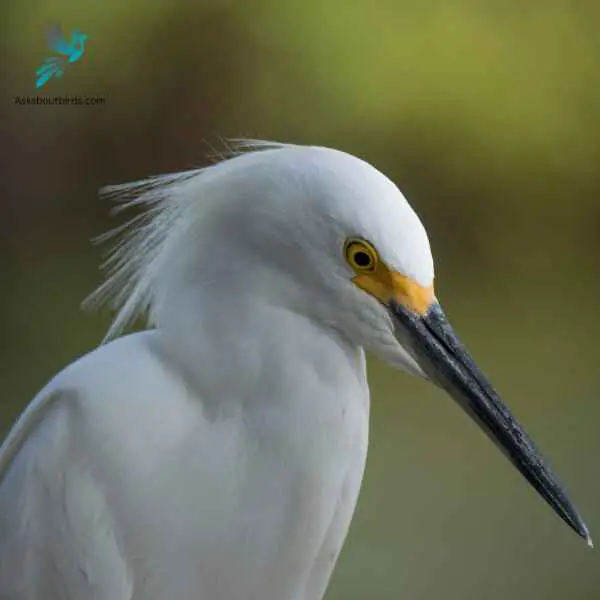
| Feature | Measurement |
|---|---|
| Scientific Name | Egretta thula |
| Length | 22.1–26.0 in |
| Wingspan | 39.4 in |
| Weight | 370 g |
The Snowy Egret (Egretta thula) is a small and active wading bird, celebrated for its delicate beauty. It sports an entirely white plumage that appears to glow against its black bill and legs, and striking yellow feet, which often play a crucial role in luring prey during feeding.
The Snowy Egret is further adorned with fine, plume-like feathers on its head, neck, and back during the breeding season, making it one of the more distinctive heron species.
Inhabiting wetland areas across the Americas, the Snowy Egret can be found in marshes, swamps, shorelines, and tidal flats where it feeds primarily on fish, but also consumes insects, crustaceans, and small reptiles.
Green Heron

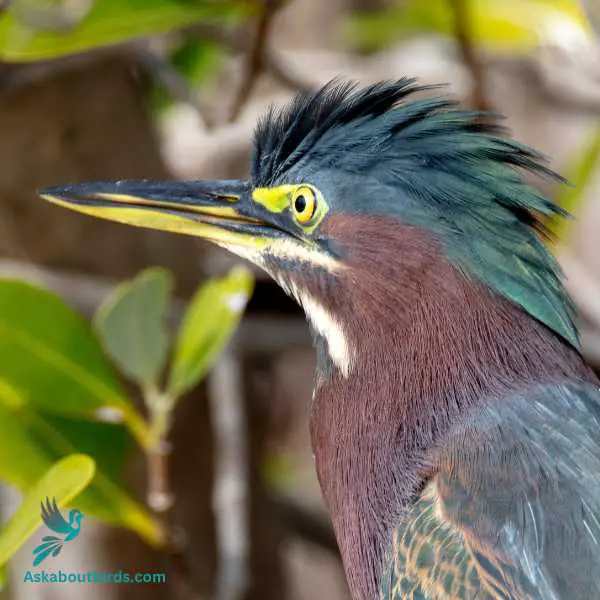
| Feature | Measurement |
|---|---|
| Scientific Name | Butorides virescens |
| Length | 16-18 inches |
| Wingspan | 25-27 inches |
| Weight | 6-7 ounces |
The Green Heron is a small heron found in North America, notable for its deep green back and chestnut body, as well as its unique fishing tactics.
Appearance: Green Herons are dark and compact birds with a glossy, greenish-black cap, a greenish back and wings, and chestnut neck and belly. The bill is long, dark and sharply pointed. Their legs are bright orange or yellow. Young birds are duller in color, with a dark top and streaked brown front.
Diet: The Green Heron’s diet is quite varied, consisting mostly of small fish, but also includes insects, spiders, and sometimes amphibians and small mammals. It’s known for its tool-using behavior where it drops bait onto the water’s surface to attract fish.
Reproduction: Green Herons are solitary birds except during the breeding season, where they form monogamous pairs. Nests are typically built in trees or shrubs near water. Females lay 2 to 5 pale blue-green eggs that both parents incubate.
Black-Crowned Night-Heron
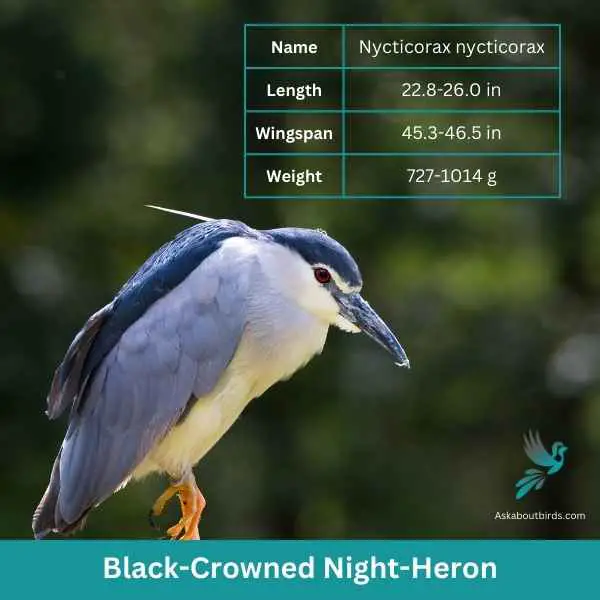
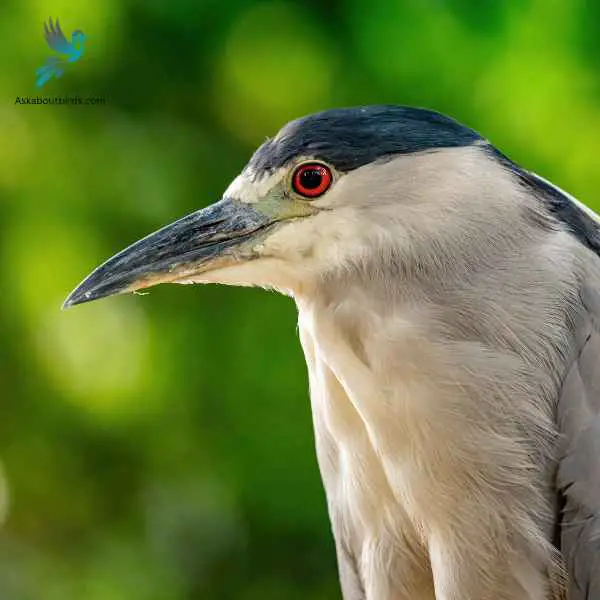
| Feature | Measurement |
|---|---|
| Scientific Name | Nycticorax nycticorax |
| Length | 22.8-26.0 in |
| Wingspan | 45.3-46.5 in |
| Weight | 727-1014 g |
The Black-Crowned Night-Heron (Nycticorax nycticorax) is a medium-sized heron species known for its distinct nocturnal habits and characteristic appearance. The bird displays a stocky silhouette, with a black crown and back, contrasting starkly with its light grey wings and white underparts.
Its eyes are large and red, adapted for its night-time activities, and its legs are relatively short for a heron. The bill is sturdy and black, and during the breeding season, two to three long white plumes extend from the back of the head.
Residing in a wide variety of wetland habitats, from freshwater marshes to coastal regions, the Black-Crowned Night-Heron is found across a large global range, including the Americas, Europe, Asia, and Africa. The species primarily feeds on fish and invertebrates, but it is known to be opportunistic and will also eat small mammals, birds, and eggs.
Yellow-crowned Night-Heron (Nyctanassa violacea)
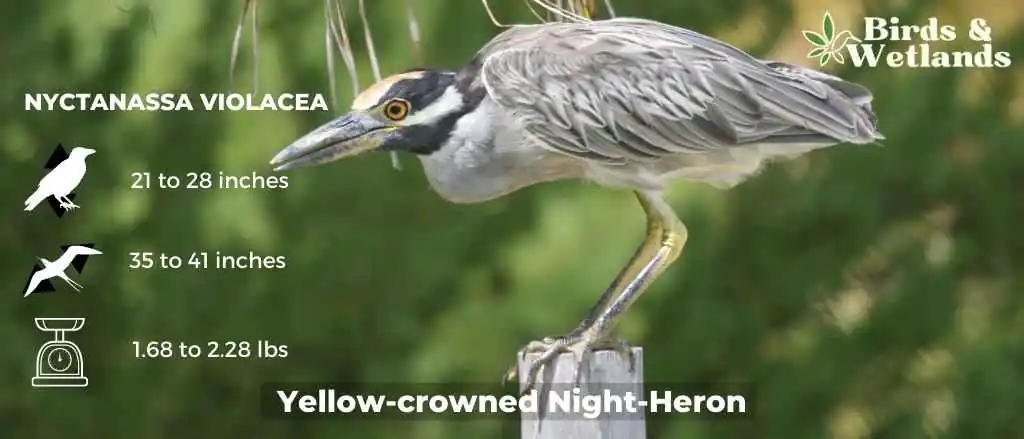
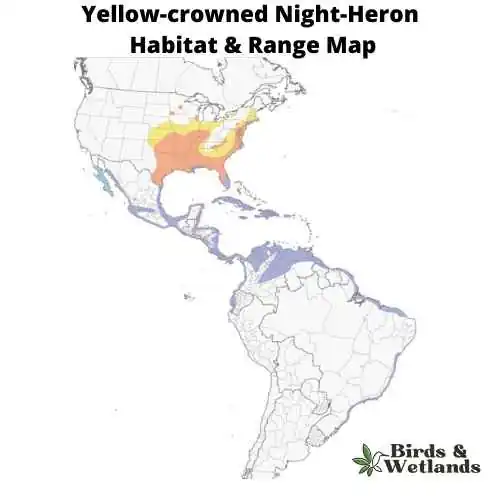
Listen:
Scientific Name: Nyctanassa violacea
Length: 1 ft 10 in – 2 ft 4 in
Wingspan:
Weight: 1.43–1.87 lb
The Yellow-crowned Night Heron is a medium-sized heron commonly found in wetlands and coastal habitats across the southeastern United States.
Appearance: Yellow-crowned Night Herons have a sturdy body with a comparatively short neck and legs. Their distinctive feature is their namesake yellow crown, which contrasts sharply with their gray body and back. They have red eyes and a heavy, dark bill. During the breeding season, they develop long, wispy plumes on their head, giving them a stylish appearance.
Diet: Yellow-crowned Night Herons are known for their preference for crustaceans, especially crabs and crayfish. They hunt mostly at night, stalking their prey in shallow water, often remaining still for long periods before striking quickly with their bill.
Reproduction: Yellow-crowned Night Herons nest in small colonies, typically in trees or shrubs near water. The female lays 3 to 5 pale blue-green eggs which are incubated by both parents for about 25 days. After hatching, the chicks are cared for by both parents and fledge in about 30-40 days. They often return to the same nesting sites year after year.
Mallard
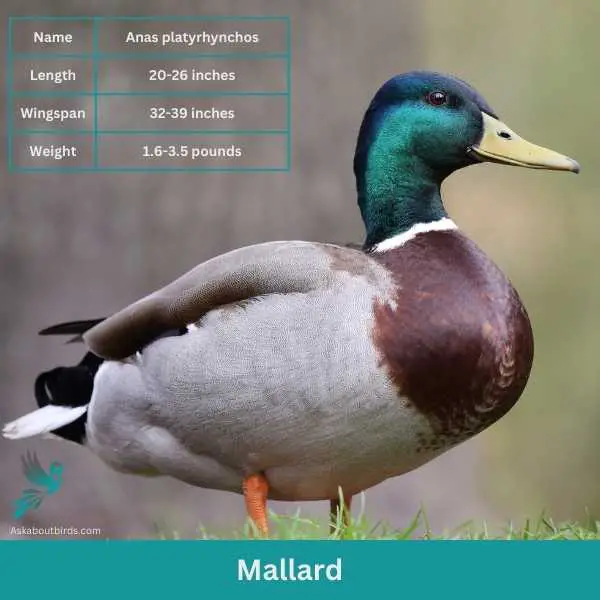
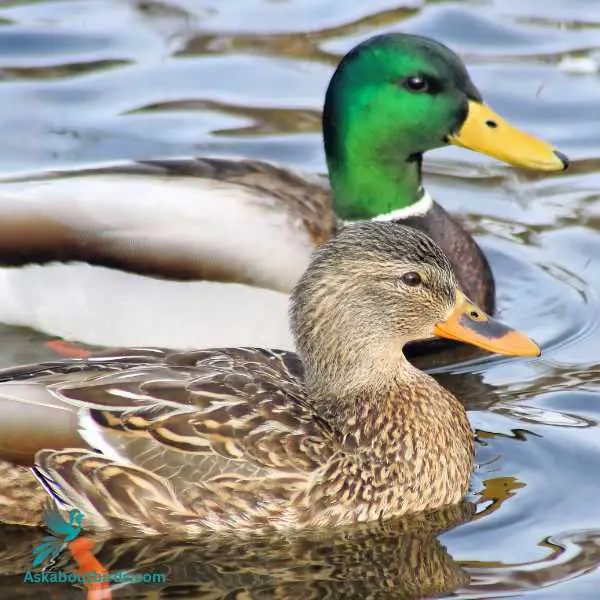
| Feature | Measurement |
|---|---|
| Scientific Name | Anas platyrhynchos |
| Length | 20-26 inches |
| Wingspan | 32-39 inches |
| Weight | 1.6-3.5 pounds |
The Mallard, one of the most recognizable of all ducks, is distinguished by its classic “quack” and its common presence in city parks and wild wetlands.
Appearance: Mallards are large ducks with a hefty body and rounded head. The male is notable for its glossy green head, gray body, and black tail-curl, while the female is mottled brown with an orange-brown bill. Both sexes have a white-bordered, blue “speculum” patch in the wing.
Diet: Mallards are omnivorous, dabbling ducks that eat a wide variety of foods. They are known to feed on aquatic vegetation, insects, worms, and grains. In city parks, they are often seen eating bread, popcorn, and other food provided by humans, although such items are not part of their natural diet.
Reproduction: Mallards nest on the ground on dry land that is close to water, under cover of tall grass or other vegetation. The female typically lays around 8 to 13 eggs and incubates them herself.
Wood Duck

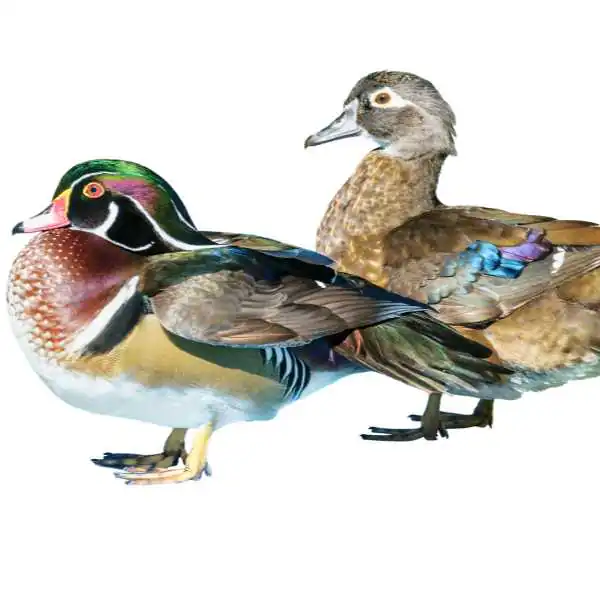
Listen:
Scientific Name: Aix sponsa
Length: 19 to 21 in
Wingspan: 26 to 29 in
Weight: 16.0-30.4 oz
The Wood Duck is an exquisitely colorful waterfowl known for its unique nesting habits and is commonly seen in wooded swamps, marshes, and streams across North America.
Appearance: With their dazzling plumage, Wood Ducks are among the most stunning birds. Males display a multitude of colors, including a green and purple crested head, red eyes, and a white-striped chest, all contrasted with a bronze-colored body. Females, though more subdued with a gray-brown body and white eye-ring, also possess their own charm.
Diet: Wood Ducks have a diverse diet that includes seeds, fruits, and insects, as well as other invertebrates. Their broad diet helps them to adapt to a variety of habitats, whether in the wild or in urban areas with suitable nesting sites.
Reproduction: Unlike most other ducks, Wood Ducks prefer to nest in tree cavities near water, leading to their common name. They will also readily use nest boxes if they’re available. A typical clutch consists of 9 to 14 eggs, which the female incubates alone.
Blue-winged Teal
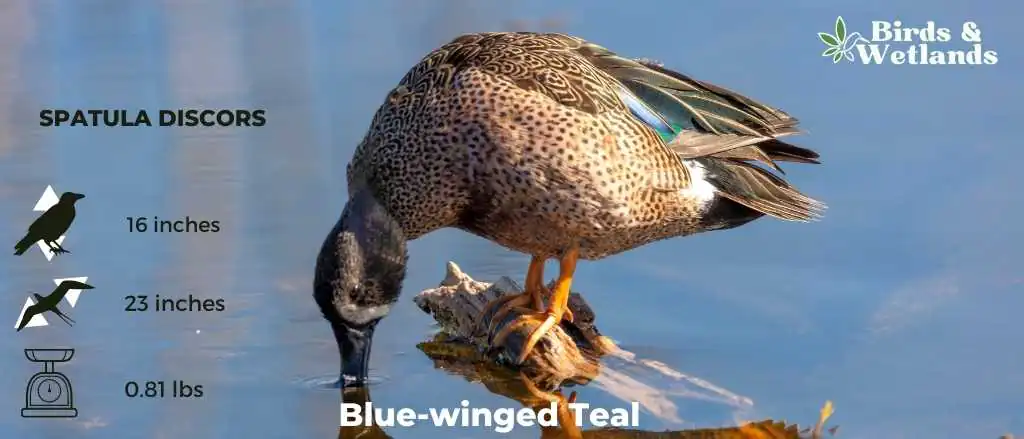
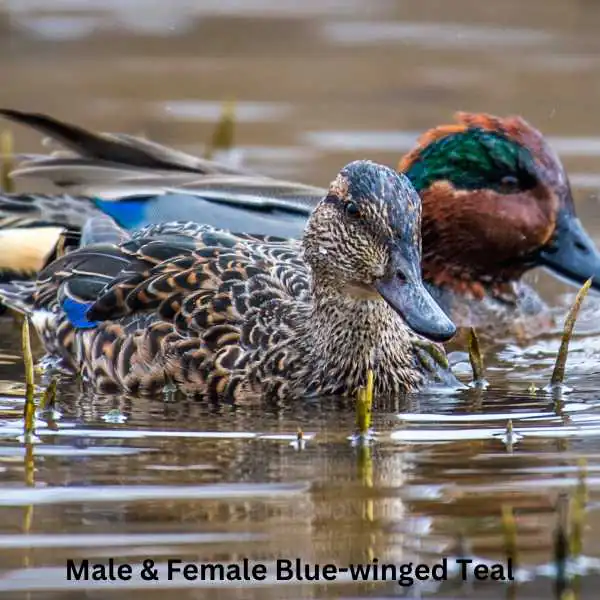
Listen to Blue-winged Teal
Scientific Name: Spatula discors
Length: 16 in
Wingspan: 23 in
Weight: 13 oz
The Blue-winged Teal is a small species of dabbling duck known for its striking plumage and its extensive migratory habits.
Appearance: Male Blue-winged Teals are quite colorful, with a slate gray head and neck, a white crescent in front of the eyes, and a predominantly brown body with specks of black. The name “Blue-winged” comes from the patch of blue feathers visible on their wings during flight. Females, in contrast, are primarily brown and subtly mottled to provide camouflage.
Diet: The Blue-winged Teal feeds mainly on plant matter, such as seeds and aquatic vegetation. However, they also supplement their diet with small invertebrates, especially during the breeding season. They are known for their “dabbling” behavior, where they feed at the surface of the water rather than diving.
Reproduction: Blue-winged Teals prefer to nest on the ground in grassy areas near water. The female typically lays a clutch of 9 to 13 eggs, which she incubates alone for about three weeks. After hatching, the ducklings can feed themselves but remain under the mother’s protection until they are capable of flying.
Northern Pintail
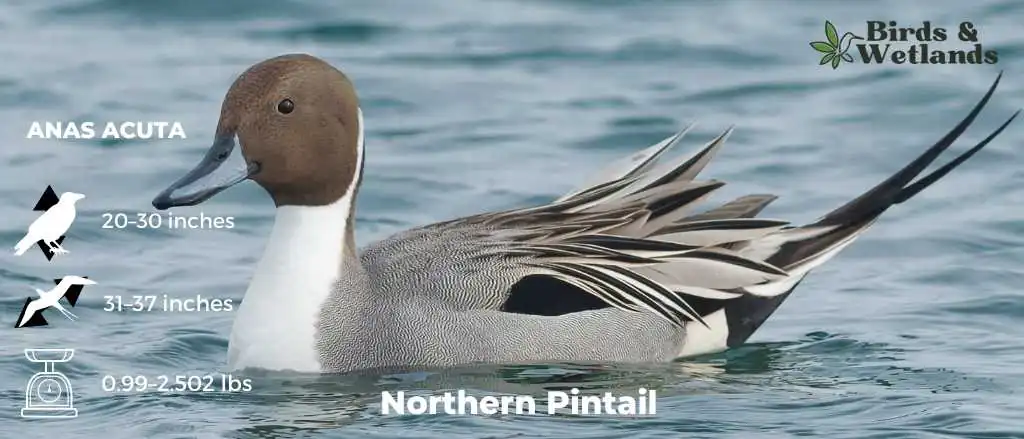
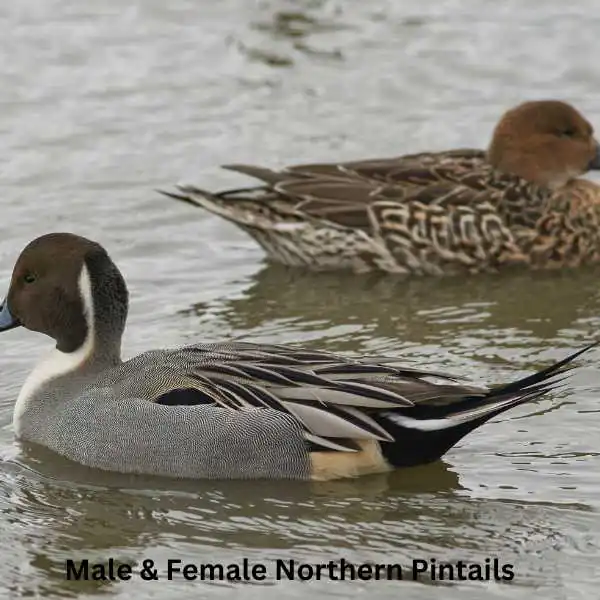
Listen to Northern Pintail
Scientific Name: Anas acuta
Length: 23–30 in
Wingspan: 31–37 in
Weight: 1 –3 lb
The Northern Pintail is a graceful species of duck recognized for their elegance in flight and their sleek bodies and long tails which is pin-shaped.
Male Northern Pintails are celebrated for their distinctive appearance, featuring a chocolate brown head, a white neck, and a grayish body. The most notable characteristic is the long, pointed tail feathers, which give this species its name. Females are more understated in color, sporting a mottled brown plumage.
Diet: Consists primarily of plant matter, including seeds and aquatic vegetation. They are also known to eat insects, especially during the breeding season. The Northern Pintail is often seen dabbling and upending in water bodies to forage for food.
Reproduction: Northern Pintails usually nest on the ground, near water bodies. The female lays a clutch of 7 to 9 eggs and is solely responsible for their incubation, which lasts for about three weeks.
Redhead
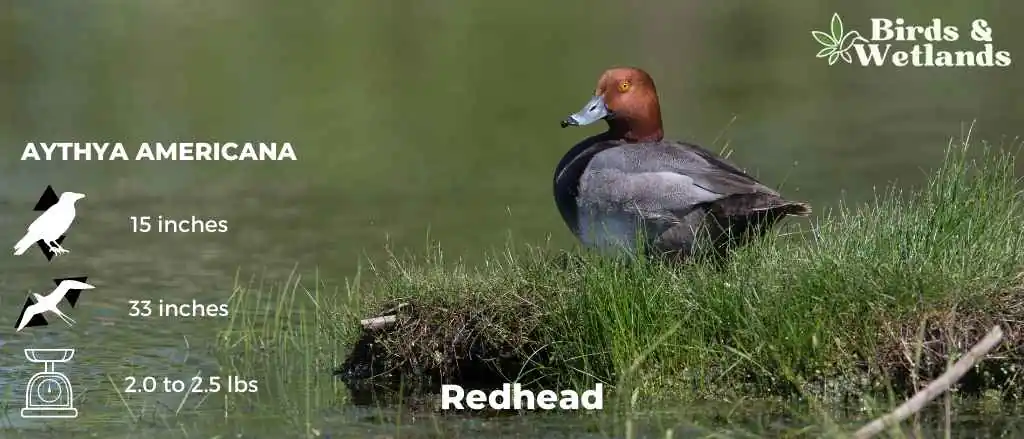
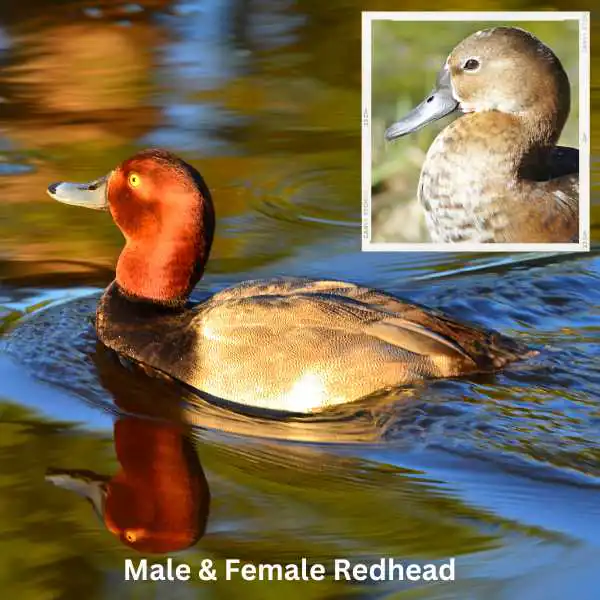
Listen
Scientific Name: Aythya americana
Length: 15 in
Wingspan: 33 in
Weight: 2.0 to 2.5 lbs
The Redhead is a medium-sized diving duck species recognized by its rounded head and broad blue bill. This bird is frequently found in wetlands, ponds, and open water bodies across the United States.
Appearance: The male Redhead is particularly striking, characterized by a coppery red head, black breast, and a gray body. The female is less colorful, featuring a brownish body and a duller, brownish-red head. Both sexes have a prominent blue bill with a black tip.
Diet: Redheads feed on a variety of items, including aquatic plants, seeds, and tubers. They also consume aquatic invertebrates, particularly during the breeding season.
Reproduction: Redheads often nest in marshes and ponds with dense vegetation.Females often lay their eggs in the nests of other ducks, a phenomenon known as brood parasitism. When nesting themselves, the female typically lays a clutch of 7 to 10 eggs and incubates them for about three weeks.
Ring-necked Duck (Aythya collaris)
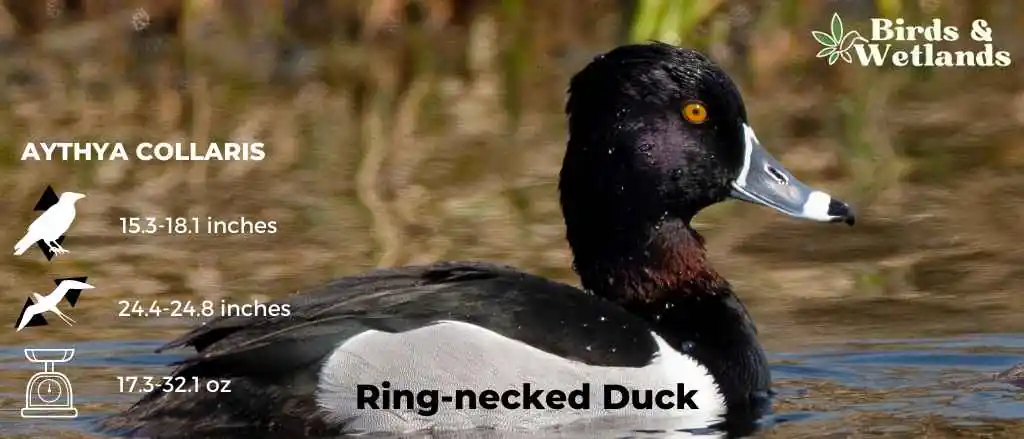
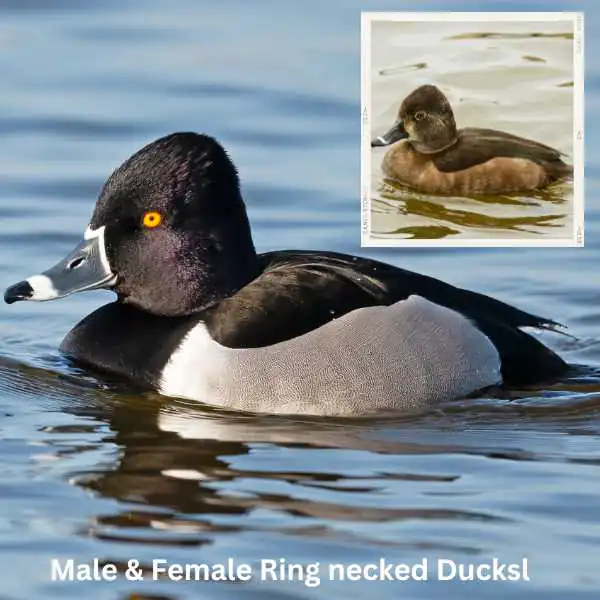
Listen
Scientific Name: Aythya collaris
Length: 15.3-18.1 in
Wingspan: 24.4-24.8 in
Weight: 17.3-32.1 oz
The Ring-Necked Duck is a small to medium-sized diving duck known for its distinctive markings and agile diving abilities.
Appearance: Male Ring-Necked Ducks are characterized by their bold black-and-white coloration, with a glossy black back, a striking white ring around the base of the bill, and two white “rings” on their flanks. Despite their name, the chestnut-colored ring around their neck is often hard to see. Females are more subtly colored with a gray-brown body and a white eye-ring.
Diet: These ducks have a varied diet that includes aquatic plants, seeds, and invertebrates, which they obtain by diving underwater in both shallow and deep water bodies.
Reproduction: The Ring-Necked Duck nests near water, often in densely vegetated areas. The female typically lays between 8 to 10 eggs, which she incubates alone, but both parents will care for the ducklings once they hatch.
Bufflehead
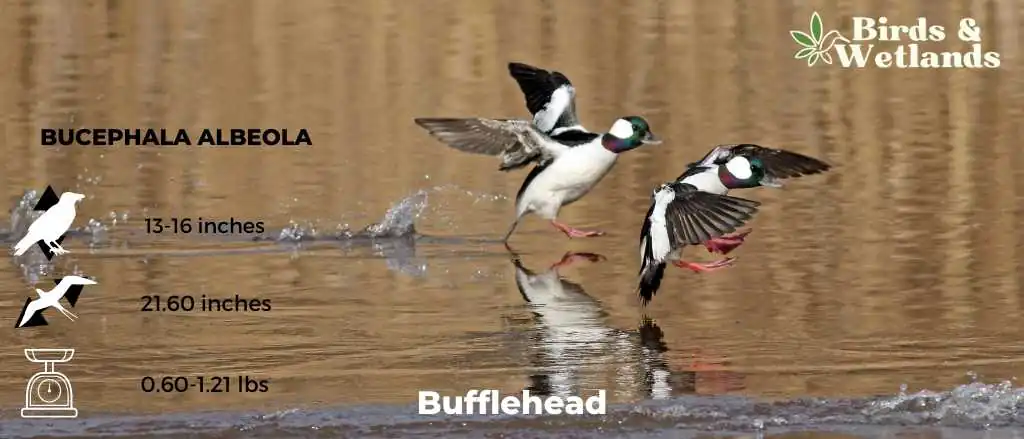
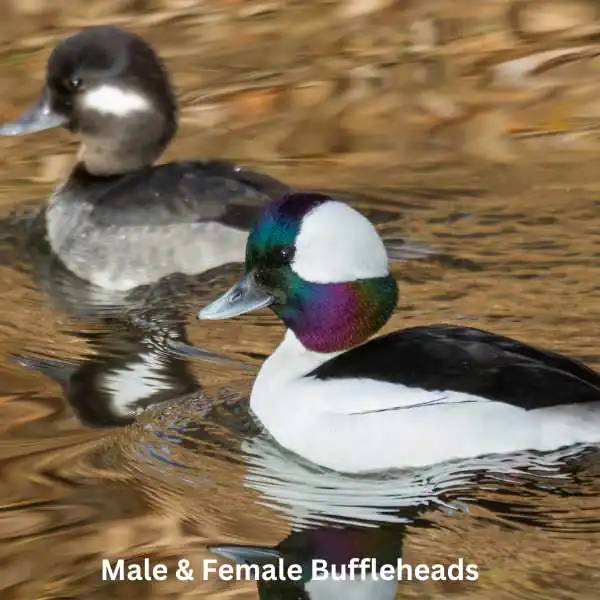
Listen to Bufflehead
Scientific Name: Bucephala albeola
Length: 13–16 in
Wingspan: 21.6 in -23.2 in
Weight: 9.5–19.4 oz
The Bufflehead is a small, compact species of diving duck known for its striking appearance and large heads and unique nesting habits.
Appearance: Male Buffleheads are easily recognized by their large, bulbous head with a green-purple iridescent sheen, a large white patch across the back of the head, and a predominantly black and white body. Females are more subtly colored, primarily in gray-brown tones with a smaller white cheek patch.
Diet: As diving ducks, Buffleheads feed by diving beneath the water’s surface. Their diet consists largely of aquatic invertebrates, such as insects, crustaceans, and mollusks, as well as some plant matter.
Reproduction: Uniquely among ducks, Buffleheads often nest in tree cavities, especially those made by Northern Flickers, a type of woodpecker. The female lays a clutch of about 6 to 11 eggs, which she incubates alone for roughly a month.
Hooded Merganser

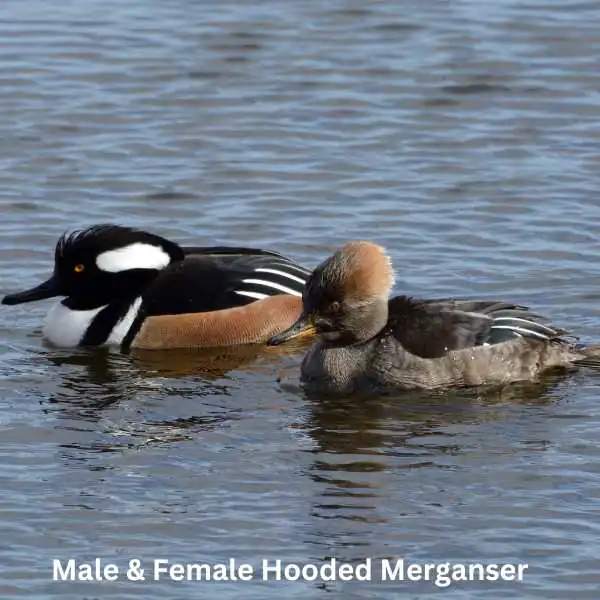
Listen to Hooded Merganser
Scientific Name: Lophodytes cucullatus
Length: 15.8-19.3 in
Wingspan: 23.6-26.0 in
Weight: 16.0-31.0 oz
The Hooded Merganser is a distinctive species of diving duck known for its showy crest and its excellent diving skills.
Appearance: Male Hooded Mergansers are especially striking with a large, fan-shaped, black and white crest, which can be expanded or contracted. They have bright yellow eyes, a dark back, and a white chest. The females have a more understated appearance with a brownish body, a smaller, reddish-brown crest, and dark eyes.
Diet: Consists of small fish, aquatic insects, and crustaceans. Their eyes are specially adapted for underwater vision, allowing them to spot and catch prey while diving.
Reproduction: Similar to Buffleheads, Hooded Mergansers often nest in tree cavities near water bodies. The female lays a clutch of about 10 to 12 eggs and incubates them alone for about a month.
Common Merganser
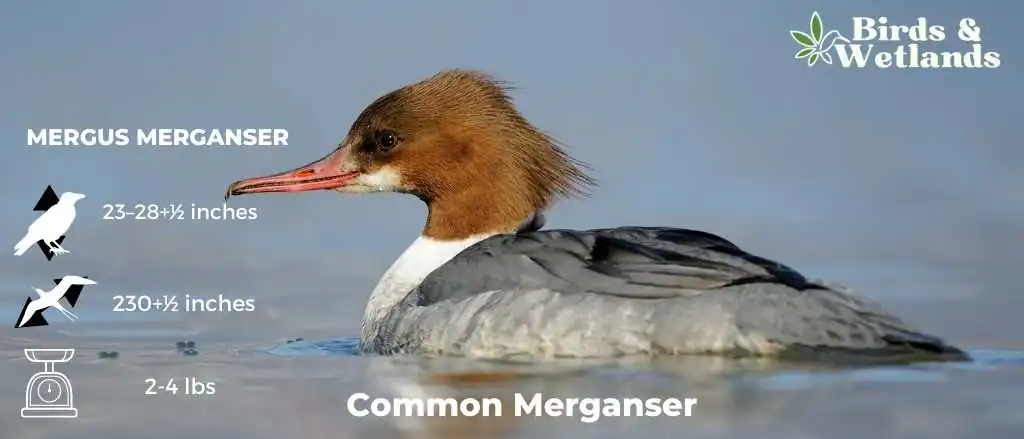
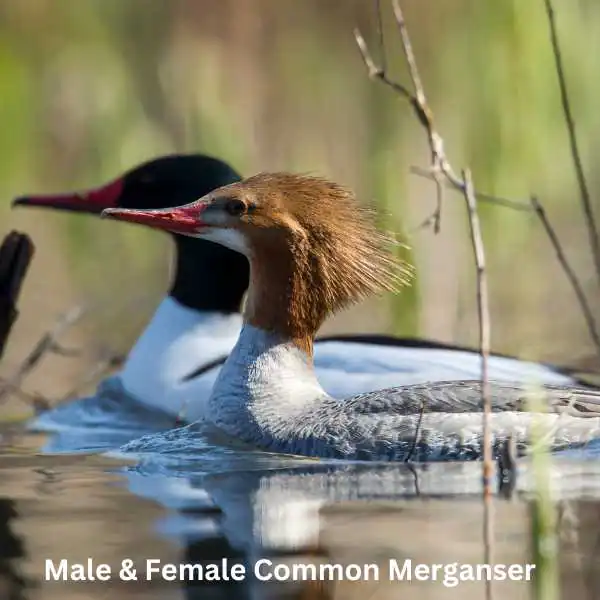
Listen:
Scientific Name: Mergus merganser
Length: 23–28 in
Wingspan: 30 – 38 in
Weight: 2 lb 0 oz – 4 lb 10 oz
The Common Merganser is a large and elegant diving duck, famous for its unique fishing abilities and seen often in the lakes, rivers, and coastal areas across North America.
Appearance: The male Common Merganser is quite striking with its dark green, almost black, crested head, bright red bill, and white body tinged with salmon-pink. The females have a reddish-brown crested head, a white neck, and a grayish body, but share the same red bill as the males.
Diet: True to their diving duck status, Common Mergansers are exceptional hunters, primarily feeding on fish. They’re also known to consume aquatic invertebrates and, on occasion, small mammals and birds. Their serrated bills are specialized to hold slippery fish tightly.
Reproduction: Like the Wood Duck, Common Mergansers also nest in tree cavities or nest boxes close to water bodies, but can also use rock crevices or holes in the ground. A clutch usually contains 9 to 12 eggs, incubated solely by the female.
American Coot
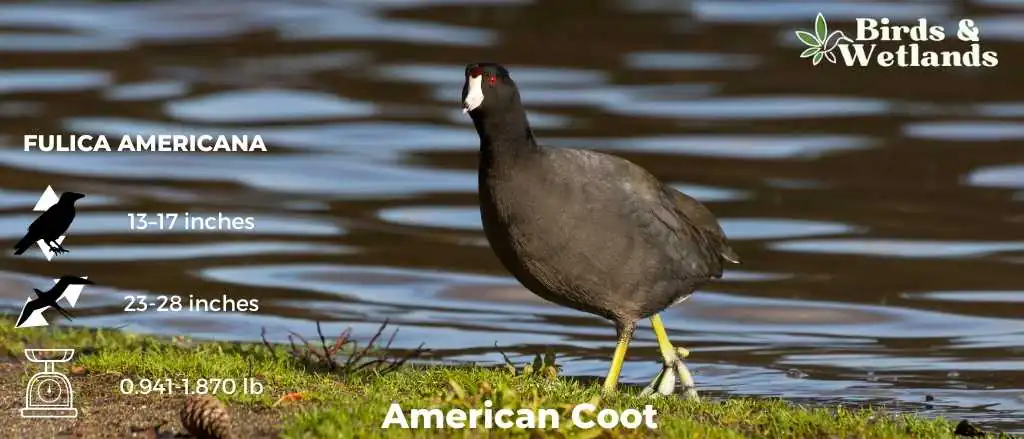
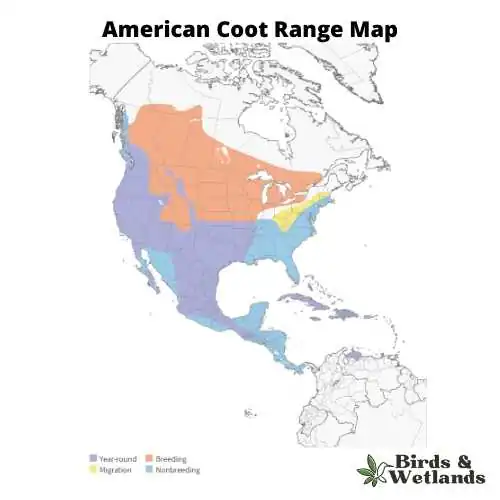
Listen:
Scientific Name: Fulica americana
Length: 13–17 in
Wingspan: 23 to 28 in
Weight: 1.270 to 1.870 lb
The American Coot is a ubiquitous water bird commonly seen in the wetlands, lakes, and ponds of North America, recognized for its adaptability and striking features.
Appearance: American Coots are easily identifiable by their slate-gray bodies, offset by a white, chicken-like bill and a red eye. Their legs are also distinctive, equipped with lobed toes, as opposed to the webbed feet seen in ducks, which assist them in navigating both land and water adeptly.
Diet: While aquatic plants form the bulk of an American Coot’s diet, they aren’t strictly herbivores. These versatile birds also consume small invertebrates and fish, demonstrating their ability to adapt and survive in a variety of habitats.
Reproduction: Nesting for the American Coot usually happens in shallow water bodies, where they construct a floating nest hidden among the vegetation. A clutch can contain between 8 to 12 eggs, all of which are incubated by both parents.
Sandhill Crane
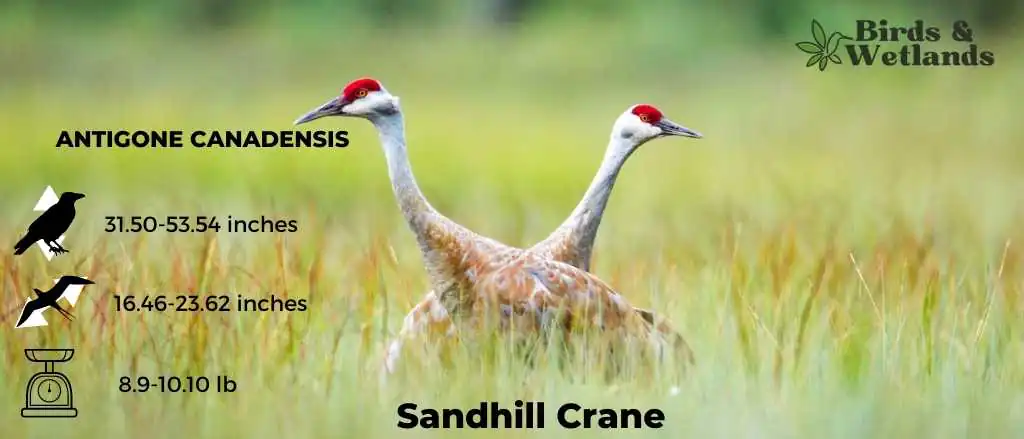

Listen:
Scientific Name: Antigone canadensis
Length: 2 ft 7-4 ft 6 in
Wingspan: 16.5–23.6 in
Weight: 4 – 4.5 kg
The Sandhill Crane is a tall, elegant bird known for its impressive size and striking appearance. They are found across North America, in habitats ranging from wetlands to grasslands.
Appearance: Sandhill Cranes are recognized for their tall stature, gray body, long legs, and long neck. Their most distinctive feature is a red forehead, which contrasts with their otherwise primarily gray plumage. During the breeding season, their gray feathers often take on a rusty-brown hue due to them rubbing iron-rich mud onto their feathers.
Diet: Sandhill Cranes are omnivorous birds and their diet is quite diverse, consisting of seeds, grains, berries, insects, small mammals, reptiles, and amphibians. They are known to forage while walking in shallow water or in fields.
Reproduction: Sandhill Cranes mate for life and their complex courtship dance is a sight to behold. They nest in marshy areas and the female typically lays two eggs.
American Wigeon

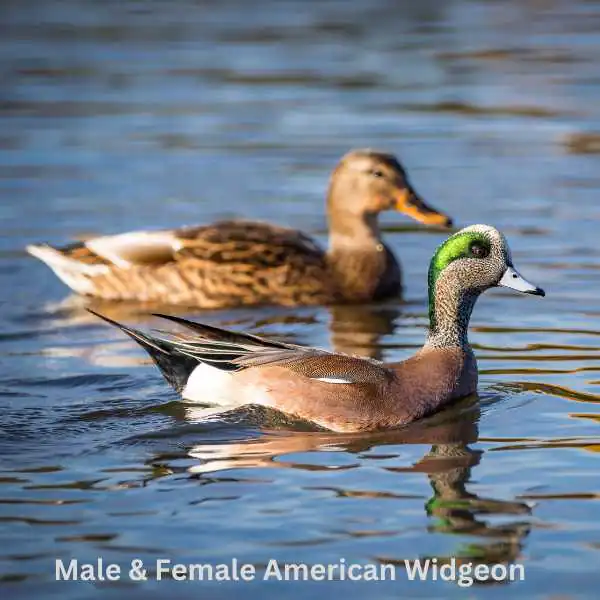
Listen to American Wigeon
Scientific Name: Mareca americana
Length: 17–23 in
Wingspan: 30–36 in
Weight: 1 –3 lb
The American Wigeon is a medium-sized duck species that is a popular sight in wetlands, ponds, and lakes and is often seen in mixed flocks with other ducks.
Males of the species are recognized by their distinctive appearance. They sport a unique white forehead and crown, coupled with a green band stretching from the eye to the back of the head. The body is mainly gray with a pinkish hue on the chest. Females are more subdued in color, with primarily gray and brown tones.
Diet: comprising mainly plant material like aquatic vegetation and grasses, but it also includes insects and other small invertebrates. They are known for a feeding behavior called “kleptoparasitism,” where they often snatch food from other ducks.
American Wigeons usually breed in the northernmost parts of North America. The females create their nests on the ground, often hidden in tall grass near water bodies. They lay a clutch of 6 to 11 eggs which they incubate for about three to four weeks and the ducklings feed on small aquatic invertebrates and aquatic insects.
Black Skimmer (Rynchops niger)
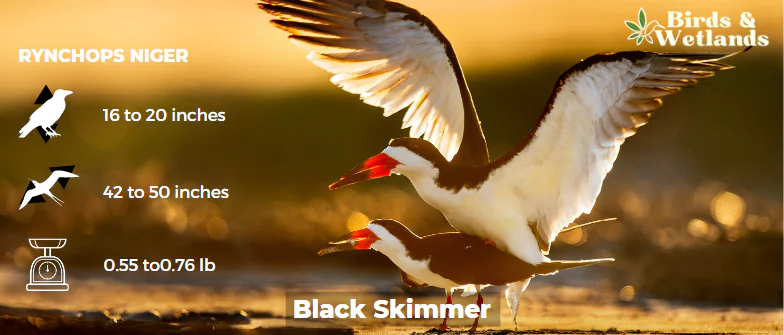
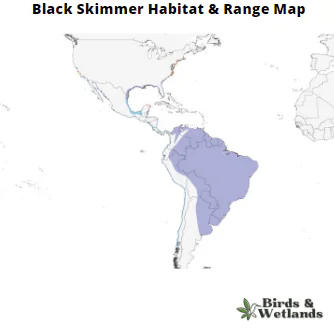
Listen:
Scientific Name: Rynchops niger
Length: 16–20 in
Wingspan: 42–50 in
Weight: 9-12.5oz
The Black Skimmer is a unique coastal bird recognizable for its unusual feeding method, giving it a fascinating presence on the beaches and sandbars it calls home.
Appearance: The Black Skimmer sports a stark contrast in color with a black upper body and white lower body. Its most distinctive feature is its bill, which is knife-thin, bright red at the base, and black at the tip. The bird’s lower mandible is much longer than the upper, an adaptation for its unique feeding style.
Diet: As its name suggests, the Black Skimmer feeds by skimming the surface of water bodies with its elongated lower mandible to catch small fish and crustaceans. It mainly feeds at dawn and dusk, relying on touch to sense prey, making it one of the few birds to feed in near darkness.
Reproduction: Black Skimmers nest in colonies on sandbars, beaches, or dredge spoil islands, with both parents sharing incubation duties. The female lays 1 to 5 eggs, which are then incubated for about 23 days. The chicks are semi-precocial, leaving the nest a few days after hatching but staying nearby for protection and feeding by the parents.
White Ibis (Eudocimus albus)
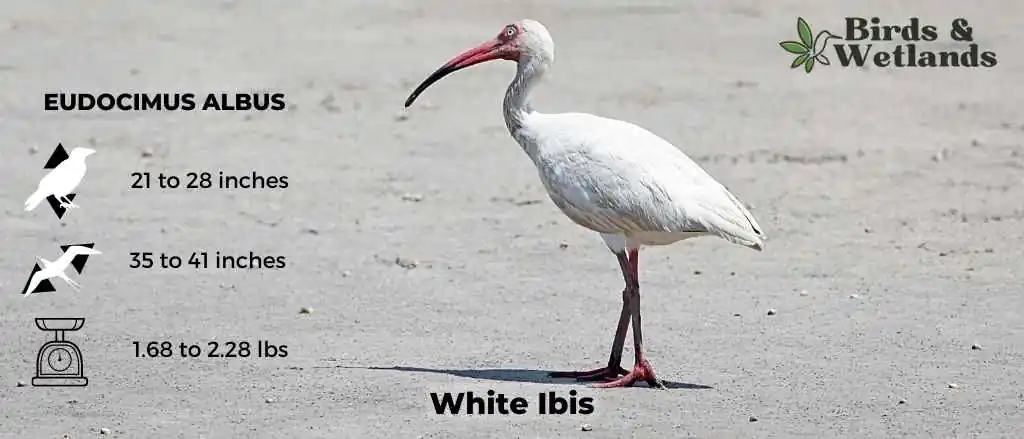
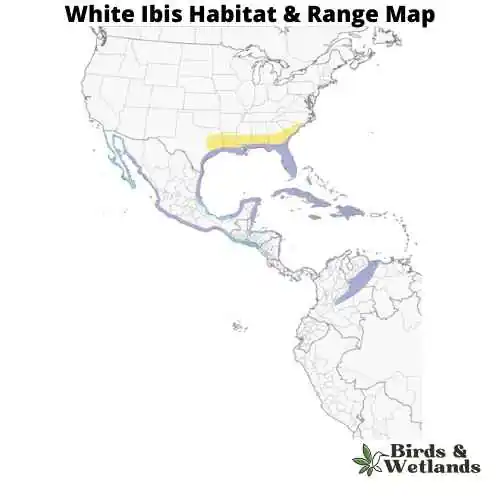
Listen:
Scientific Name: Eudocimus albus
Length: 21 to 28 in
Wingspan: 35 to 41 in
Weight: 1.6 – 2.3lb
The White Ibis is a wading bird renowned for its bright white plumage and distinctive, down-curved bill. It’s most commonly found in the marshes, wetlands, and along the coastlines of the southeastern United States.
Appearance: White Ibises display a predominantly white plumage that’s contrasted by their brilliant red-orange down-curved bill and legs. During the breeding season, the skin on their face may become dark blue. Juvenile White Ibises have brown upper parts and white underparts.
Diet: The diet of the White Ibis primarily consists of various invertebrates, including insects, crayfish, and other small crustaceans. Their long, curved bill is perfectly adapted for probing in mud and shallow water while foraging for food.
Reproduction: White Ibises nest in large colonies, often with other wading birds. The female typically lays 2 to 4 eggs in a nest made of twigs and leaves in trees or shrubs.
Belted Kingfisher (Megaceryle alcyon)
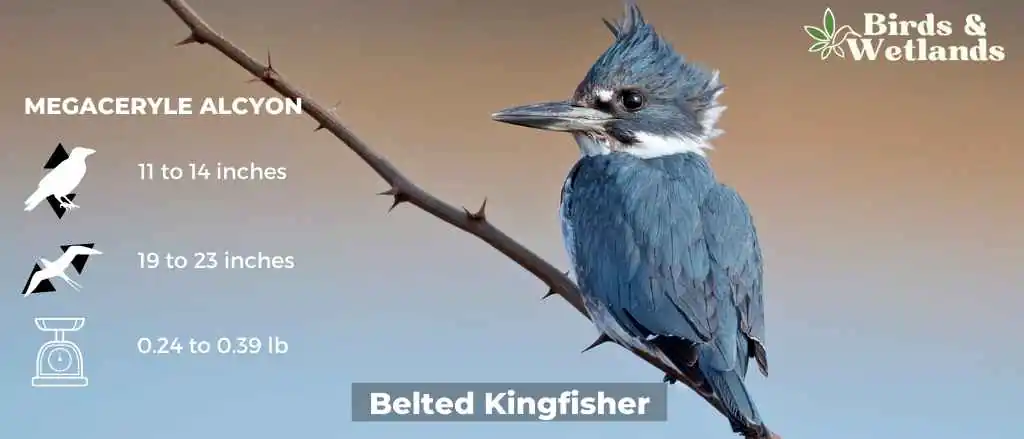
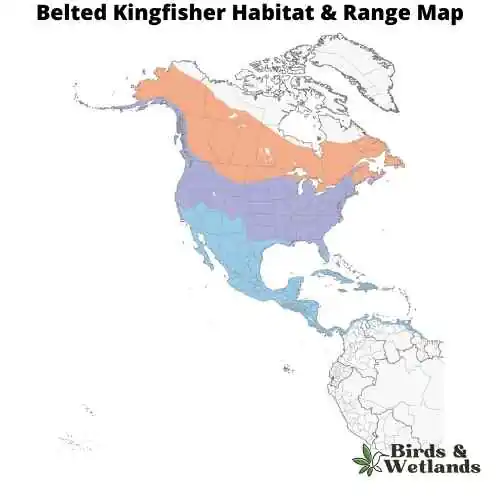
Listen
Scientific Name: Megaceryle alcyon
Length:11–14 in
Wingspan: 19–23 in
Weight: 4.0 to 6.3 oz
The Belted Kingfisher is a conspicuous water bird, known for its distinct rattling call and impressive diving abilities.
Appearance: The Belted Kingfisher is characterized by a large head with a shaggy crest and a long, thick bill. They have a blue-gray body with white underparts. A defining characteristic is the blue-gray band, or “belt,” across the chest. Males and females have similar coloration, but females have an additional chestnut-colored band on their bellies.
Diet: Belted Kingfishers are excellent fishermen, often seen perched above water bodies, such as rivers, streams, lakes, and ponds, watching for their prey. They primarily feed on fish but will also eat amphibians, crustaceans, insects, small mammals, and reptiles. They hunt by diving headfirst into the water to catch their prey.
Reproduction: Belted Kingfishers nest in burrows that they excavate in sandy or earthy banks, usually near a body of water. These burrows can be up to 8 feet deep. The female lays a clutch of 5 to 8 eggs, and both parents participate in incubation and feeding of the young.
Laughing Gull (Leucophaeus atricilla)
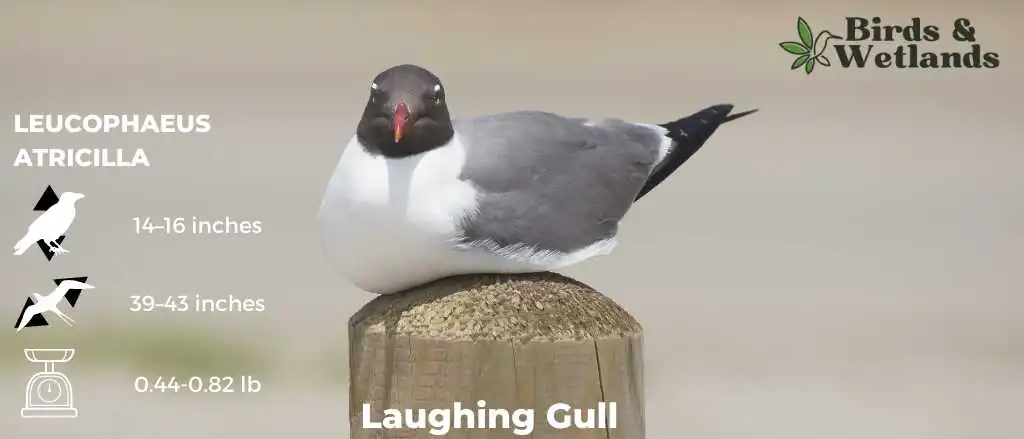

Listen:
Scientific Name: Leucophaeus atricilla
Length: 14–16 in
Wingspan: 39–43 in
Weight: 7.2-13.1 oz
The Laughing Gull is a medium-sized coastal gull that’s notable for its distinctive call that sounds like a high-pitched laugh, giving the bird its common name.
Appearance: Adult Laughing Gulls have a dark, almost black, head in the summer, with a grey body and black wingtips. In the winter, their heads turn white with a smoky gray mask. Their legs are reddish-black, and they have a long, red bill.
Diet: Laughing Gulls are omnivores, eating a varied diet that includes fish, insects, invertebrates like shrimp and crabs, and sometimes even human food waste. They are opportunistic feeders and are often seen foraging in garbage bins in coastal towns.
Reproduction: The Laughing Gull nests in large, noisy colonies. The female typically lays 2 to 4 eggs in a nest constructed from grass, sticks, or seaweed on the ground, often on islands. Both parents take turns incubating the eggs, and after they hatch, the chicks stay in the nest for about 20 days before taking their first flight.
Where to Spot North Carolina’s Water Birds
North Carolina is known for its diverse ecosystems, from the Appalachian Mountains to the extensive coastal areas. Here are a few prime locations where you can spot the state’s impressive variety of water birds:
Pea Island National Wildlife Refuge: Located on the Outer Banks, this refuge is a stopover for hundreds of species of migratory birds and waterfowl. You may see a range of species, from ducks and geese to herons and egrets as well as plenty of other species, who love the dense vegetation.
Cape Hatteras National Seashore: With its extensive coastline, Cape Hatteras is a great spot to see coastal bird species, including gulls, terns, and pelicans (which is a very large bird) and cattle egrets..
Jordan Lake State Recreation Area: Located in the Piedmont region, Jordan Lake is known for its Bald Eagle population, but also hosts many water bird species, including herons, ducks, and Canada geese.
Alligator River National Wildlife Refuge, East Lake: Comprising over 150,000 acres of wetland habitats, you may spot birds like the American Coot, Northern Shoveler, and White-faced Ibis.
Cape Fear River, Wilmington: The diverse ecosystem of this large river system attracts many species of water birds such as the Green Heron, Great Blue Heron, and Black-crowned Night-Heron.
Lake Mattamuskeet, Hyde County: The lake is one of the best bird-watching spots in North Carolina, attracting large numbers of migratory birds in winter. It’s a great place to spot the Northern Pintail, Greater Scaup, and Brandt’s Cormorant.
Water birds are an integral part of North Carolina’s rich biodiversity. From the majestic Blue Heron, known for its striking appearance and size or the common canada goose as well as plenty of small birds. These avian species contribute significantly to the state’s unique ecological tapestry. North Carolina Press has highlighted the importance of water bird conservation, particularly as their migratory patterns span across both North and South America.
| Neighboring State | Best Spots for Birdwatching |
|---|---|
| Virginia Water Birds | Chincoteague National Wildlife Refuge, Great Dismal Swamp National Wildlife Refuge, Back Bay National Wildlife Refuge |
| South Carolina Water Birds | Huntington Beach State Park, Congaree National Park, Bear Island Wildlife Management Area |
| Georgia Water Birds | Harris Neck National Wildlife Refuge, Sapelo Island National Estuarine Research Reserve, Jekyll Island |
| Tennessee Water Birds | Reelfoot Lake State Park, Great Smoky Mountains National Park, Radnor Lake State Park |

